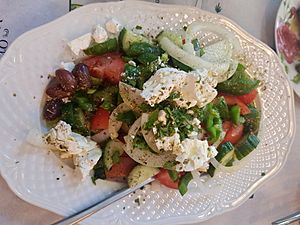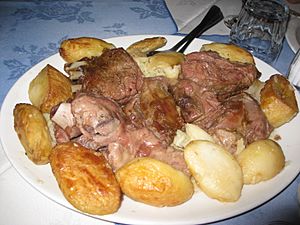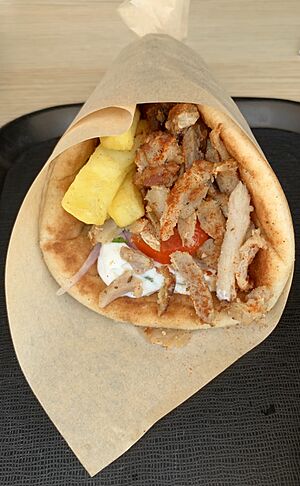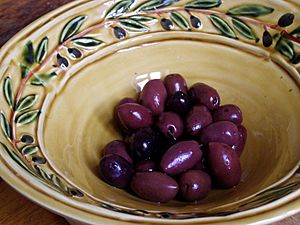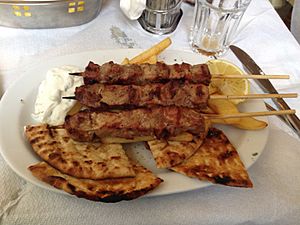Greek cuisine facts for kids
Greek cuisine is the delicious food from Greece and places where Greek people live around the world. Like many other foods from the Mediterranean area, it uses three main things: wheat, olive oil, and wine.
Greek food also uses lots of fresh vegetables, fish, and different kinds of meat like pork, chicken, veal, beef, lamb, rabbit, and goat. Other important ingredients are pasta, cheeses, lemon juice, herbs, olives, and yogurt. Bread made from wheat is very common. You'll also find barley used, especially in hard breads called paximathia. For desserts, Greeks often use nuts, honey, fruits, and thin pastry called filo.
Greek cooking has a long history. It carries on traditions from Ancient Greece and the Byzantine times. It also has influences from Balkan, Turkish, and Italian foods.
Contents
A Look Back at Greek Food History
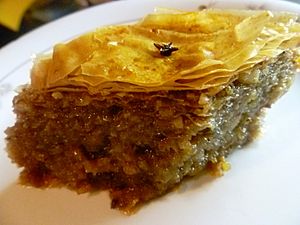
Greek food is a big part of Greek culture. We can see its history in old pictures and writings. Greek cooking even influenced ancient Rome and then spread across Europe.
Food in Ancient Greece
Food in Ancient Greece was quite simple. It was based on the "Mediterranean triad": wheat, olive oil, and wine. People didn't eat meat very often. Fish was much more common, especially for those living near the sea. This way of eating continued for a long time, even in places like Cyprus. Wine and olive oil have always been super important. When Greeks traveled and started new settlements, they often brought grapevines and olive trees with them.
The Spartans, a famous group of ancient Greeks, also ate very simply. One well-known Spartan dish was melas zomos, or "black soup." It was made by boiling pig's blood with vinegar. Other Greeks often talked about this soup as proof of how different the Spartans were.
Food in Byzantine Times
Byzantine cuisine was similar to ancient Greek food. But new ingredients were added, like caviar, nutmeg, and basil. Lemons, which are very common in Greek cooking today, were first used as medicine before becoming a food ingredient. Fish remained a key part of the diet for people living by the coast. The Byzantines also benefited from their capital city, Constantinople, being a major center for the spice trade. This meant they had access to many different spices.
What Makes Greek Food Special?
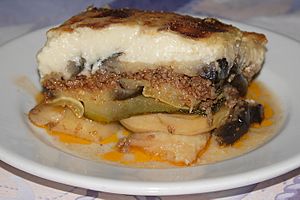
The most special and oldest part of Greek cooking is olive oil. It's used in almost every dish! Olive oil comes from the many olive trees that grow all over Greece. It gives Greek food its unique taste. Olives themselves are also eaten a lot.
The main grain in Greece is wheat, but barley is also grown. Important vegetables include tomatoes, eggplants, potatoes, green beans, okra, green peppers, and onions. Greek honey often comes from fruit trees like lemon and orange, or from thyme and pine trees. A special aromatic resin called Mastic is grown only on the island of Chios.
Greek food uses some flavors more often than other Mediterranean cuisines. These include oregano, mint, garlic, onion, dill, cumin, coriander, and bay laurel leaves. Other common herbs are basil, thyme, and fennel seed. Parsley is also used to decorate some dishes. In northern Greece, people sometimes use "sweet" spices like cinnamon, allspice, and cloves in meat stews.
Because of the climate and land, it's easier to raise goats and sheep in Greece than cattle. That's why beef dishes are not as common. Fish dishes are very popular in coastal areas and on the islands.
Greek cuisine uses many different types of cheese. Some famous ones are Feta, Kasseri, Kefalotyri, Graviera, Anthotyros, Manouri, Metsovone, and Mizithra.
Eating out is very common in Greece. Tavernas and estiatorios are popular places. They serve homemade food at good prices for both locals and tourists.
Common street foods include souvlaki, gyros, different kinds of pitas, and roasted corn. Fast food became popular in the 1970s. Some places serve international foods like hamburgers, while others serve Greek favorites like souvlaki and gyros.
Where Greek Dishes Come From
Many Greek dishes have very old roots. For example, lentil soup and retsina (wine flavored with pine resin) can be traced back to ancient Greece. Some dishes like loukaniko (dried pork sausage) come from the Hellenistic and Roman times. From the Byzantine Empire, we get feta cheese and paximadi (a type of hard bread).
Some dishes show Italian influence. This is because parts of Greece were ruled by people from Venice and Genoa (in Italy) for a long time. Dishes like pastitsio, pastitsada, and stifado are examples of this influence.
Many Greek dishes also come from Ottoman cuisine. The Ottoman Empire ruled Greece for centuries, and their food mixed influences from Persian, Levantine, Arabic, Turkish, and Byzantine foods. Examples include phyllo pastry, tzatziki, meze (small dishes), dolma (stuffed vegetables), hummus, pita bread, baklava, and halva.
In the 20th century, French cuisine also had a big impact on Greek cooking. A famous Greek chef named Nikolaos Tselementes, who trained in France, created the modern Greek pastitsio and the modern version of moussaka.
Different Flavors Across Greece

Just like in other countries, different parts of Greece have their own special foods. Here are a few examples:
- Aegean Islands: Food from islands like Kyklades and Rhodes.
- Ionian Islands: Food from these islands has a lot of Italian influence.
- Crete: Known for its healthy and delicious Cretan cuisine.
- Macedonia: Food from the northern region of Greece.
- Asia Minor Greeks: People whose families came from Asia Minor (modern-day Turkey) have their own unique dishes, often with Ottoman influences.
- Pontic Greeks: Greeks from the Black Sea region also have special foods.
Some smaller groups of people living in Greece also have their own traditional foods, like the Aromanians and their Aromanian cuisine.
Popular Greek Dishes
Many Greek foods are wrapped in filo pastry. These can be small triangles or large sheets. Some examples are:
- Kotopita (chicken pie)
- Spanakopita (spinach and cheese pie)
- Hortopita (greens pie)
- Kreatopita (meat pie, with minced meat)
- Kolokythopita (zucchini pie)
Greeks use filo pastry in countless ways, similar to how Italians use pasta to make many different dishes. They have endless types of pitas (savory pies).
Greek cuisine also uses seeds and nuts in many dishes, from pastries to main meals. The list of Greek dishes has even more examples of foods found all over Greece and some regional specialties.
|
See also
 In Spanish: Gastronomía de Grecia para niños
In Spanish: Gastronomía de Grecia para niños


